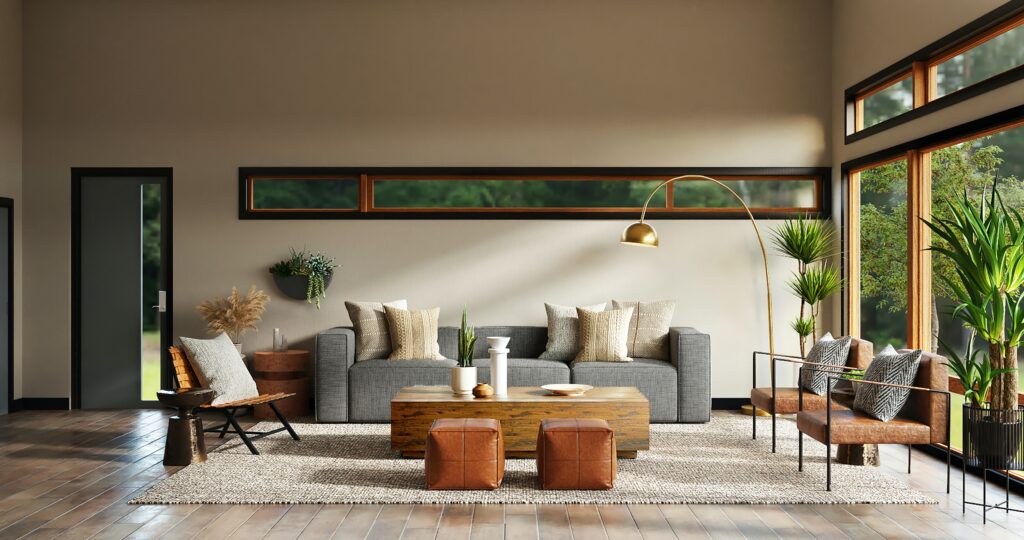With the constant technological advancements and urbanization, people have become more disconnected from nature. The resulting stress and anxiety have led to a growing trend toward incorporating biophilic design in interior spaces. Biophilia, derived from the Greek words: “bio,” meaning life, and “philos,” meaning love, is the innate human connection with nature. This design concept aims to bring the essence of nature indoors to improve the well-being and productivity of individuals. By using natural elements such as plants, sunlight, water, and raw materials, biophilic design creates a sense of harmony and balance in indoor spaces.

Understanding Biophilic design
Biophilia is not a new concept; our ancestors have lived in harmony with nature for centuries. However, it was in the 1980s that biophilic design gained recognition in the interior design industry. This design approach considers humans part of the natural world and seeks to connect them and their surroundings. Incorporating natural elements in indoor spaces has been proven to reduce stress levels, increase concentration, and enhance creativity, improving overall well-being. Biophilic design is not limited to residential areas; it can be applied to any interior space, including offices, schools, healthcare facilities, and hospitality.
Identifying the principles of Biophilic design
The principles of biophilic design revolve around the idea of creating a connection with nature. These principles include incorporating natural light, views of nature, natural patterns and textures, and plants into the interior space. Natural light is essential as it regulates our circadian rhythm and helps us maintain a healthy sleep-wake cycle. Views of nature have a calming effect on individuals and can improve their mood and productivity. Using natural patterns and textures, such as wood and stone, helps create a sense of connection with nature. Incorporating plants adds visual appeal, improves air quality, and reduces stress.
How to incorporate Biophilic design in interior spaces
Incorporating biophilic design in interior spaces requires a thoughtful and strategic approach. It involves selecting the correct elements and placing them strategically to create a sense of connection with nature. One of the critical elements of biophilic design is natural light. Designers can use techniques such as skylights, windows, and light wells to bring natural light into a space. Views of nature can be incorporated by strategically placing windows and creating green spaces indoors. The use of raw materials, such as wood, stone, and water features, makes a sense of connection with nature and adds visual interest to the space. For example, epoxy resin flooring in the UK is a popular choice as it mimics the look of natural stone while being durable and low maintenance. Designers can also incorporate living walls, potted plants, or moss to add a touch of nature to the space.
The benefits of incorporating Biophilic design
The benefits of incorporating biophilic design in interior spaces are numerous. It can improve individuals’ well-being and mental health by reducing stress and promoting calm and relaxation. It can be especially beneficial in high-stress environments such as offices or healthcare facilities.
Biophilic design has been shown to increase productivity and creativity. Individuals are more likely to feel inspired and motivated by creating a connection with nature, leading to better performance. It can also improve air quality and regulate temperature, creating a healthier indoor environment.
Incorporating biophilic design can have a positive impact on the environment. Using natural materials and plants reduces the carbon footprint of the space and promotes sustainable living. It also helps in reducing energy consumption by maximizing the use of natural light and ventilation.
Overcoming challenges in incorporating Biophilic design
While the benefits of biophilic design are clear, there can be challenges in incorporating it into interior spaces. One of the main challenges is cost. Using natural materials and elements can be expensive, and some clients may not have the budget. However, with increasing awareness and demand for sustainable living, designers can find affordable options incorporating biophilic design principles.
Another challenge is maintenance. Plants require regular care, and natural materials may require special cleaning and maintenance. It is essential to consider these factors when selecting elements for biophilic design and ensure they fit the client’s lifestyle and budget.
It is also crucial to balance incorporating natural elements and maintaining functionality and practicality in the space. A well-designed biophilic space should not sacrifice functionality for aesthetics.
Future of Biophilic design in interior spaces
The future of biophilic design in interior spaces looks promising as more individuals and organizations recognize the benefits of incorporating nature into their surroundings. Technological advancements will allow more ways to incorporate natural elements seamlessly into indoor spaces.
As society becomes more conscious about sustainability and the environment, biophilic design will continue to promote sustainable living significantly. Designers will be responsible for incorporating sustainable practices and materials into their designs.
It is also expected that biophilic design will become more mainstream and accessible as its popularity grows. It will lead to more affordable options and a more comprehensive range of materials and elements.
